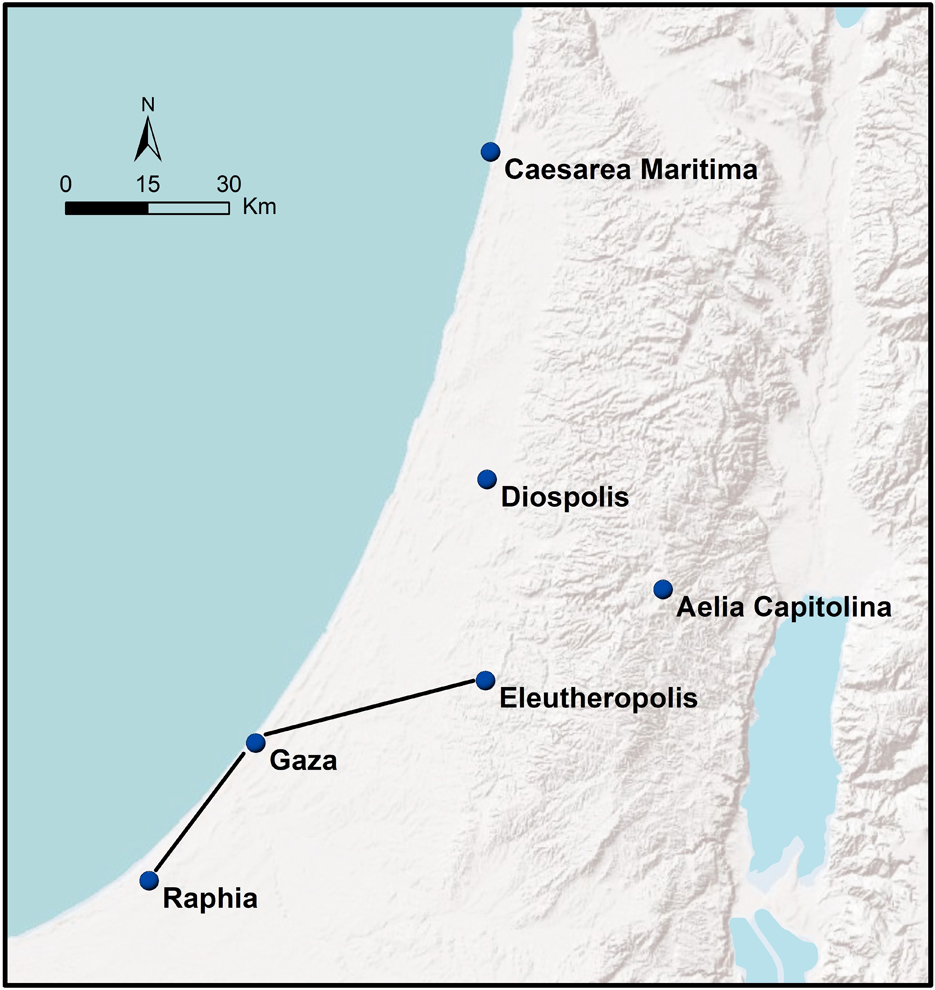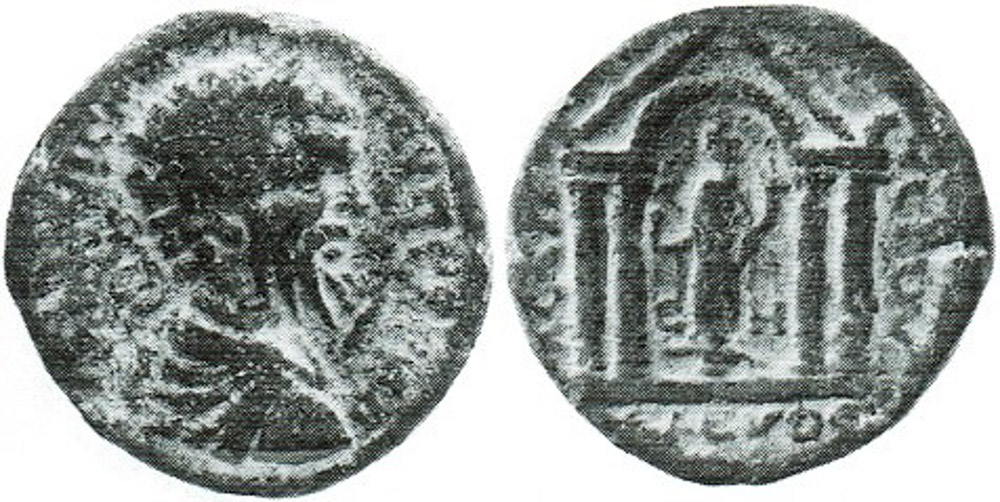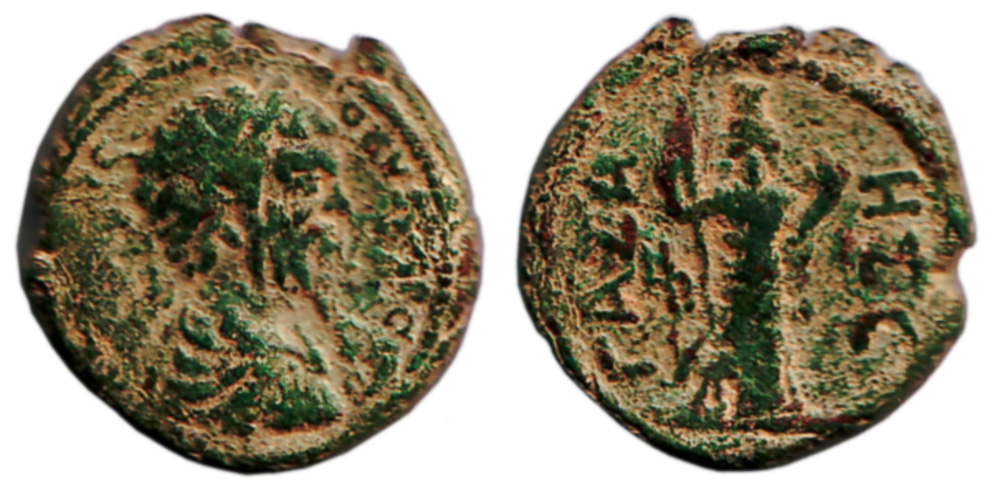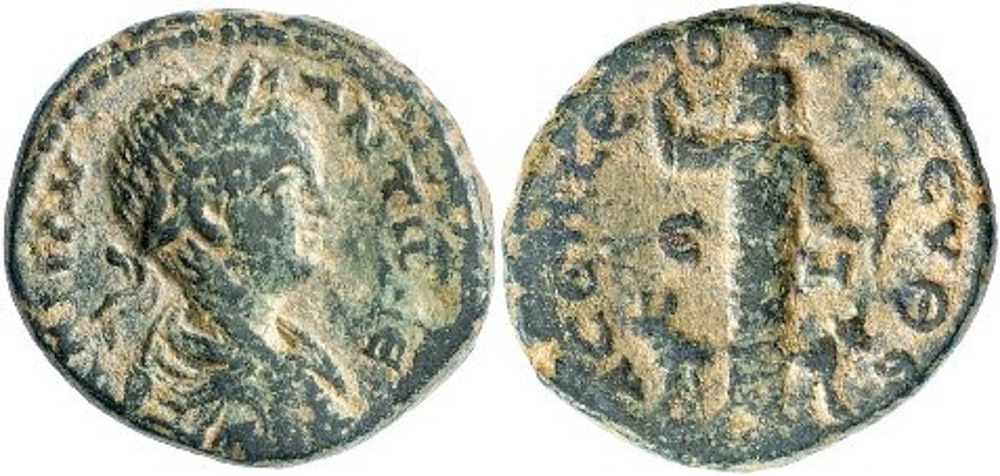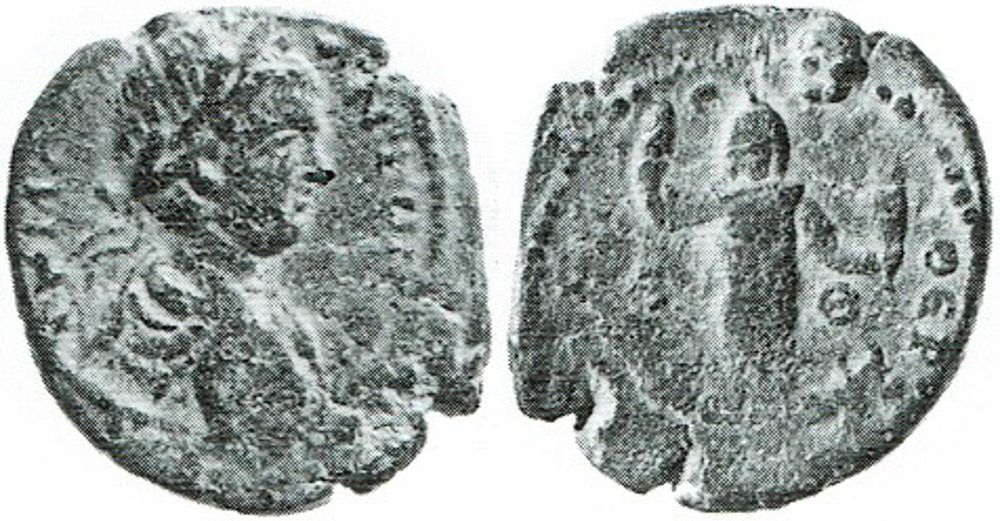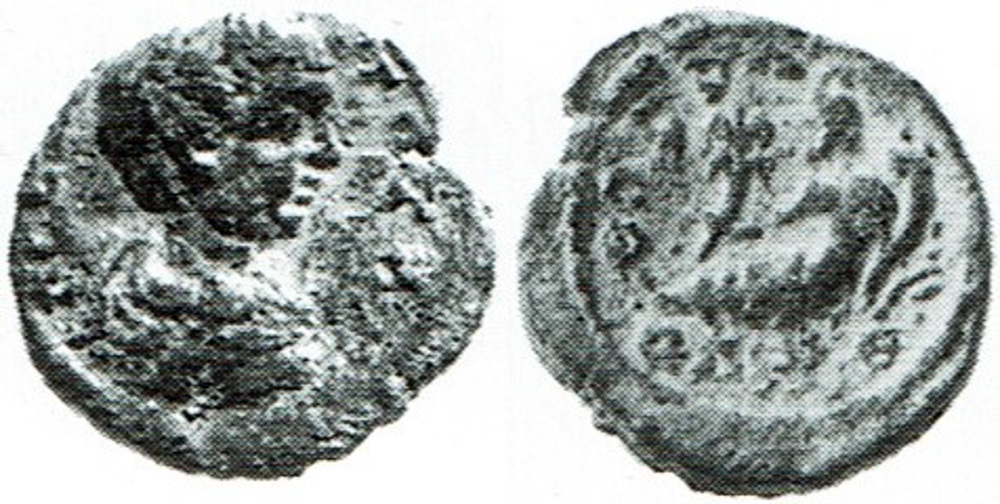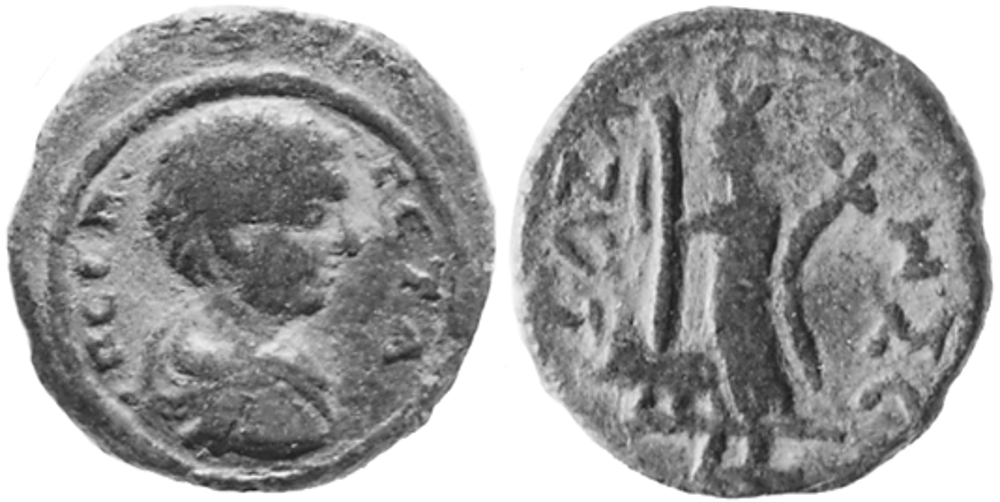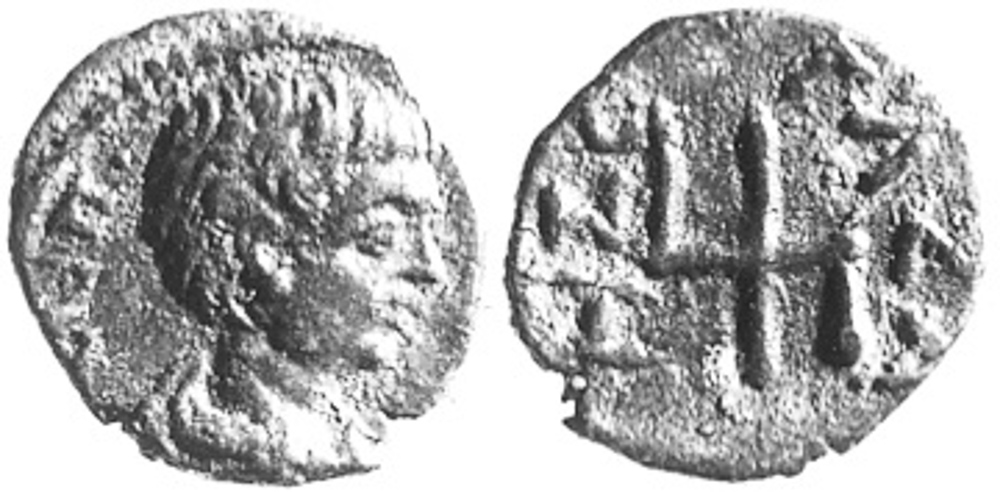Eleutheropolis and Gaza: A Newly Discovered Die Sharing in Roman Palestine
Abstract:
This paper presents a new occurrence of die sharing in Roman
Palestine, this time between Eleutheropolis and Gaza under
Septimius Severus.
Key Words:
Roman provincial coinage, Roman Palestine; die sharing,
Septimius Severus
Zusammenfassung:
Der Artikel präsentiert eine neue Stempelkoppelung aus dem
Römischen Palästina, in diesem Fall eine Verbindung zwischen
Eleutheropolis und Gaza aus der Zeit des Septimius Severus.
Schlagwörter:
Lokalprägung, Römisches Palästina, Stempelkoppelungen, Septimius
Severus
During my study of the
coinage of Gaza in the Roman period, I have noted that the
portraits on the coins of Gaza dated to year 268 (207/8 CE) are
very similar to the ones on the coins of Eleutheropolis[1],
especially those of years 8 and 9 of the local era (206/7 and
207/8 CE) and suggested that it seems possible that the dies for
both cities were cut by the same die cutter/workshop[2].
Further study of the coinage of both cities has revealed that
there is more than only similarity among the dies and, in
addition to the already published die links between Gaza and
Raphia[3],
I can now point to another instance of die sharing in Roman
Palestine, this time between Eleutheropolis and Gaza under
Septimius Severus.
It seems that at least
four of the obverse dies used for the four known types struck in
Gaza in 207/8 CE are known from coins of Eleutheropolis dated to
206/7 and 207/8 CE (Table 1)[4].
The largest denomination in both cities was struck in the name
of Septimius Severus (No. 1); the second denomination in
both cities was struck in the name of young Caracalla (No. 2);
the smallest denomination in both cities is in the name of Geta.
One denomination in his name is known in Eleutheropolis, with a
similar type in Gaza (No. 3), while another, smaller
denomination, is only known in Gaza (No. 4), possibly
struck by the same die used for the previous denomination but on
a smaller flan, thus producing a smaller denomination. It should
be noted that the series in Eleutheropolis dated Year 9 (207/8
CE) also included an obverse die in the name of Julia Domna[5],
which was not used in Gaza.
|
No. |
Eleutheropolis
(206/7–207/8 CE) |
Gaza (207/8 CE) |
|
1 |
CHL 110, No. 5 |
Jeselsohn coll.
(Farhi 2013, 236*, Type 249b.2) |
|
Obv. Laureate, draped and
cuirassed bust of Septimius Severus r., A K
Λ
CЄΠ
CЄ-OЄV
ΠЄP
CЄΒ |
||
|
2 |
Stack’s Coin
Galleries December 2006
Auction
(13.12.2006), Lot 98
CHL 110, No. 16 |
Yashin 2007, 95,
No. 460; Farhi 2013, 237*, Type 250.a.1a |
|
Obv. Laureate, draped and
cuirassed bust of young Caracalla r., AV K M AV·-·ANTω CЄ· |
||
|
3 |
CHL
110, No. 23 |
CHL 122, No.
189; Farhi 2013, 238*, Type 251.a.1 |
|
4 |
|
Yashin 2007, 95,
No. 461; Farhi 2013, 238*, Type 252a.1b |
|
Obv. Draped and
cuirassed bust of Geta r., bareheaded; Π CЄΠ·-·ΓЄTA
K |
||
The fact that at least
two obverse dies (Nos. 1–2 above) are known from dated
coins of Eleutheropolis earlier than they are known on the coins
of Gaza indicate that dies from Eleutheropolis were brought to
Gaza rather than the opposite.
This is especially
interesting in the case of Gaza since it was the only city in
the region to mint regularly under Septimius Severus already
from 193/4 CE and up to 207/8 CE. No new coins were minted in
Gaza in the final years under Septimius Severus (208/9‒210/1
CE). The fact that Gaza probably did not produce new obverse
dies during 207/8 CE but used obverse dies of Eleutheropolis
suggests that the local mint already had some difficulties
during this year. However, it should be noted that Gaza did
produce the reverse dies for the types struck during this year.
This fact proves that at least in some cases the obverse and
reverse dies were definitely cut by different die cutters and
probably by different workshops.
The difficulties of the
local mint seem to continue during the final years of Septimius
Severus and into the reign of Caracalla as evidenced by the fact
that from 208/9 to 213/4 CE Gaza did not produce any new dies
and did not strike new coins at all but used dated countermarks
which were punched on earlier coins of the city instead. In
addition, one bronze specimen only (in the name of Julia Domna)
is known under Caracalla in 214/5 CE and no coins of the city
are known for 215/6 CE.
Thus, it seems that
during 207/8 CE Gaza used obverse dies of another city
(Eleutheropolis) together with reverse dies which had probably
been produced in Gaza itself; after this year and during the
rest of the period under Septimius Severus and Caracalla (up to
214/5 CE), no obverse or reverse dies were used and no coins
were struck in Gaza at all (above). This seems to indicate some
kind of deterioration in the local coin production.
It also Indicates that the die cutter who worked for
Eleutheropolis did not move to Gaza in 207/8 CE and cut the dies
there. Additional evidence for the deterioration in
the local coin production in Gaza during 207/8 CE compared to
Eleutheropolis is the evidence that the coins of Gaza which were
struck in 207/8 CE seem to be less common than those struck by
Eleutheropolis using the same dies (I know of 16 such coins of
Gaza and 49 of Eleutheropolis)[6].
The fact that Gaza, the
oldest, largest and most important city in southern Roman
Palestine, used dies of a new and smaller city which had no
minting activity before the period of Septimius Severus, is
surprising and might point to a real difficulty that Gaza had
during 207/8 CE as well as to the rising (economic?) power of
Eleutheropolis under Severus, who made it a polis c. 200 CE[7].
However, 207/8 CE was also the last year under Severus in which
coins were struck in Eleutheropolis, so the fact that both Gaza
and Eleutheropolis did not strike coins during the final years
of Severus (208/9–210/1 CE) might suggest regional issues which
caused some difficulties for these cities and others as well[8].
The phenomenon of die
sharing between cities is known from other regions as well, such
as, Asia Minor, the Peloponnesus, Syria and Arabia, in the late
second and third centuries CE. In his work on the coinage of
Asia Minor, Konrad Kraft demonstrated by means of die links that
central cities/mints produced coins for smaller cities[9].
The same practice was attested by Kevin Butcher, who proved that
Syrian Antioch produced coins for numerous cities in northern
Syria and for Philippopolis in Arabia in 218–253 CE (Butcher
1986–1987:73–84, Pls. 24–29; 1988:63–75). Susanne Grunauer-von
Hoerschelmann found stylistic peculiarities of obverse dies of
Corinth from the Severan period that are also found on obverses
of coins from some Peloponnesian towns. She assumed that direct
models from Corinth were copied in multiple towns, and suggested
two possible reasons for this: Either a single workshop in
Corinth provided all the dies for the surrounding cities or a
travelling Corinthian workshop, equipped with model coins of the
Severan family, traveled across the Peloponnesus and coined
wherever they received orders and bronze bullion[10].
George Watson has recently published a new corpus
of shared dies of Roman provincial coinage in which he also
mentioned the existence of die sharing amongst cities of Arabia
and the Decapolis during the reign of Elagabalus[11].
We have no certain
answer to the question of what might be the reasons and the
motivation for the die sharing between Eleutheropolis and Gaza.
Maybe there was a need for a special permission to cut and use
obverse dies and for some reason Gaza had problems in getting
this permission during the years under discussion. Or perhaps
the cutting of new obverse dies was rather expensive and the
city (or someone on behalf of the local boule?) was trying to
save money for the city or for himself. Another option is that
there was, for some reason, lack of skilled die cutters to
perform this job.
Regarding the vast
phenomenon in Asia Minor, it was recently suggested
that the explosion in use of shared dies during the
third-century CE might be better explained by connections
between cities that were conducive to the spread of ideas than
by any inherent benefit arising from the practice itself[12].
Besides the die sharing
discussed here, we know almost nothing about possible
connections between Gaza and Eleutheropolis, except for the fact
that they shared a border[13].
Due to the very small
number of cases of die sharing in Roman Palestine, all within a
relatively short period, the possibility that the reason for the
die sharing was a result of a trend rather than a practical
issue seems to me less relevant for this region and other,
probably practical, options might be involved.
Closing remarks:
The reason for the die
sharing between Eleutheropolis and Gaza (as well as between Gaza
and Raphia) is yet unknown. The motivation for it was probably
practical. In any case it seems that the minting of provincial
coins in Asia Minor, the Peloponnesus, Syria, Arabia, the
Decapolis and southern Roman Palestine involved some similar
patterns of activities from the last quarter of the second
century CE into the first quarter of the third century CE.
Such studies, and
especially those dealing with obverse portraits and types, might
reveal connections and relations between neighboring mints such
as shown here. Moreover, it becomes clear that die studies of
bronze coins, a less developed branch of numismatic endeavor,
can significantly contribute to diverse subjects such as the
output of the mints and other purely economic aspects. I hope
that this and other studies into die links and other numismatic
connections between the mints in southern Roman Palestine will
lead to the identification of more die links in other parts of
this region as well.
[1]
Eleutheropolis is located some 45 km north-east of Gaza,
half way between Gaza and Aelia Capitolina (see Map 1)
(I wish to thank H. Cohen-Klonimus for preparing the
map). For the history of the city see TIR 118–119.
[2] Farhi
2013, 170.
[3] Farhi
2007/2008a; Farhi 2015.
[4] The
obverse die with the specific portrait of Septimius
Severus (No. 1) is already known in
Eleutheropolis in 201/2 CE (CHL 110, Nos.
2–4).
[5]
CHL 110, No. 11.
[6] It
should be noted that generally speaking, the coins of
Gaza are much more common in public and private
collections than those of Eleutheropolis. However, coins
of Eleutheropolis which are dated to the years under
discussion are more common than those of Gaza of the
same year.
[7]
Eleutheropolis become a polis, alongside Diospolis, by
Septimius Severus during his visit to the region in c.
199/200 CE (Farhi 2007/2008b, 141, 163; Kushnir-Stein
2000, 154). The first coins to be struck in
Eleutheropolis were under Septimius Severus, from 201/2
CE (year 3) to 207/8 (year 9) and the last ones under
Elagabalus in 217/8 CE (year 19). For the coins of
Eleutheropolis see Spijkerman 1972; CHL
109–111; Sandberg 2014 (the most recent paper dealing
with this city, unfortunately lacking a thorough study
and a catalogue of the coinage).
[8]
Diospolis was the only city west of the Jordan River to
strike coins during this period, and in one year only
(208/9 CE); see Farhi 2013, 203–204, Table 22. Diospolis
is located some 37 km north of Eleutheropolis (see
Map 1).
[9] Kraft 1972. See
also Johnston 1982/1983.
[10] Grunauer-von
Hoerschelmann 1982/1983.
[11]
Watson 2020, 261.
[12]
Watson 2021. See also Watson 2019 (non vidi).
[13] For
the border between Gaza and Eleutheropolis see Di Segni
2004.
